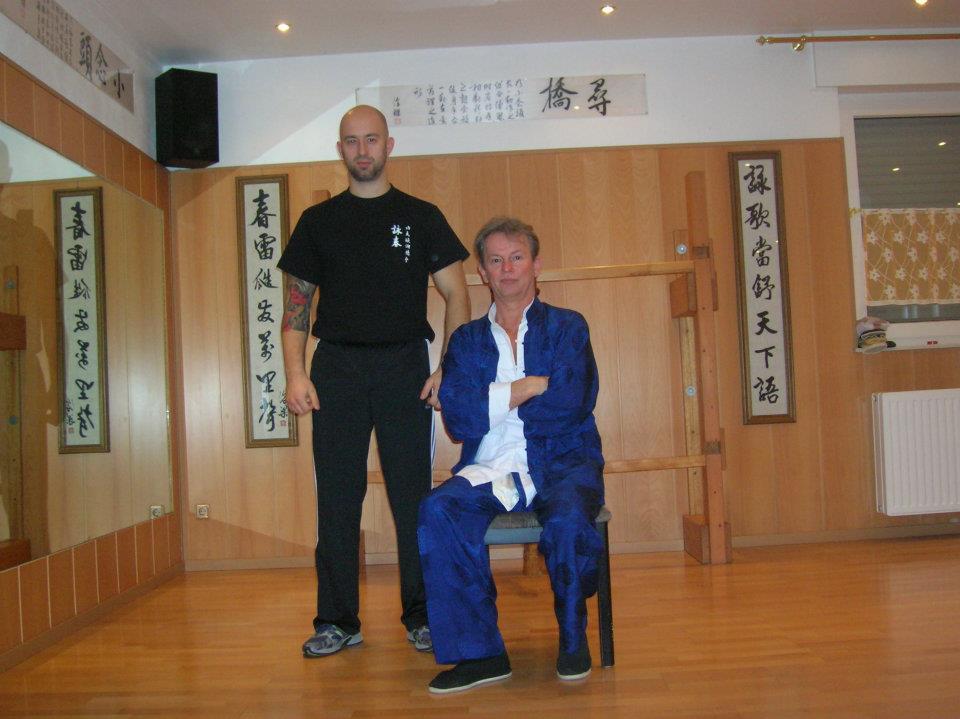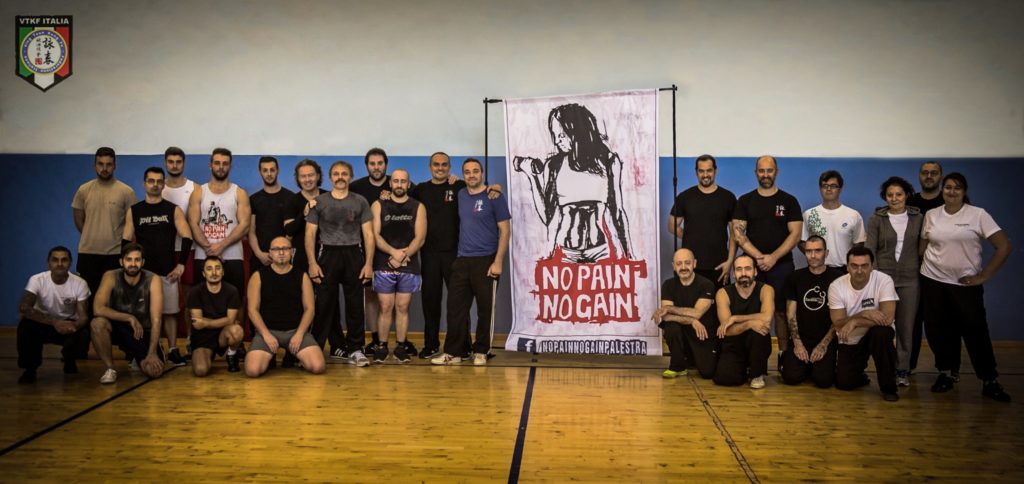Enrico Ferretti: Ving Tsun punch
Reading time: 1 minute
 Sifu Philipp Bayer with his student Enrico Ferretti[/caption]
Sifu Philipp Bayer with his student Enrico Ferretti[/caption] The advantages of the vertical punch are the following:
Ving Tsun tries to overcome these disadvantages with its peculiar foorwork, its insistent training aimed at learning the correct timing and responsiveness, as well as the use of the elbow and the arms in a coordinate manner, as explained above.
 Enrico Ferretti and the italian Ving Tsun Federation of Philipp Bayer[/caption] Chain-punching (“Lin Wan Kuenâ€) The well-known “chain-punching†is NOT a technique dealing with hitting the opponent with a series of fast punches (a strategy not so successful and effortless), but an exercise aimed at teaching the correct punching mechanics.
Enrico Ferretti and the italian Ving Tsun Federation of Philipp Bayer[/caption] Chain-punching (“Lin Wan Kuenâ€) The well-known “chain-punching†is NOT a technique dealing with hitting the opponent with a series of fast punches (a strategy not so successful and effortless), but an exercise aimed at teaching the correct punching mechanics. Comments
The Controversial Fight | Emin Boztepe vs William Cheung
When two Wing Chun Masters Fight For Real
Wing Chun Vs Karate: Full Contact Match
One of the Fiercest Wing Chun practitioners so far. He knows his Thing on the Ground too
Wing Chun Vs Boxing: Real Fight
This is what Wing Chun looks like when applied Effectively. Bravo to the Wing Chun guy
History of Wing Chun Kung Fu
Rediscovering the roots of Wing Chun.
Wing Chun VS Karate: Brutal KO
With a Fusion of Wing Chun and Pak Mei, Pierre Flores is on a Mission to restore Credibility to Traditional Martial Arts
Wing Chun (Canada) Vs Wing Chun (Vietnam)
The Rules are Simple: Wing Chun Traditional Techniques only. Kicks are not Allowed
Brutal KO by Wing Chun fighter Josh Kaldani
Josh Kaldani in MMA fight. What do you think about his techniques
36,000 Kids You Don't Want to Mess With
Kung Fu Academies are still a very Popular Choice for Eastern Families
The MMA Fighter Who Exposes Fake Martial Artists
Somebody has to do the dirty work
Wing Chun Vs MMA - Xu Xiao Dong (MMA) vs Ding Hao (Wing Chun)
Xu Xiao Dong, aka Mad Dog, is back with another fight, in this video we show you Xu Xiao Dong MMA vs Ding Hao Wing Chun. This time he challenged Ding Hao, a Wing Chun fighter.
DK Yoo teaches combat system to Korean Special Forces
DK Yoo Warfare Combat System teaches how to utilize your body in the most effective way. Here is a quick video where the System is shown on Korean Special Forces.
Bruce Lee and the Master that he couldn't defeat
Not a very well known story
Wing Chun vs Kickboxing: Wing Chun wins
That's pretty awesome
Shannon Lee: Shut Up About My Father
Tarantino: I Depicted Bruce just as Arrogant as He Was
Wing Chun in MMA: the Singapore Match
Li Zihao brings Wing Chun Inside the Cage
Kung Fu vs Karate | The Best Real Fights Compilation
Whether you're a fan of Kung Fu or Karate, you won't want to miss this intense and exciting video.
Wing Chun Vs Karate | Bare Knuckle Fight
Don't mess with Wing Chun Masters
Nobody can Beat these Shaolin Masters
Meenakshi is a 73 Year Old Woman who competes in Martial Arts and beats Men half her age
Wing Chun athlete vs Kick Boxer
This video from the versus series shows a Wing Chun athlete vs Kick Boxer in which two different boxing styles are once again testing their differences.
Tai Chi Vs MMA: The Fight Everyone is Talking About
After a long fight over the internet MMA instructor Xu Xiaodong finally gets to fight Tai Chi master Chen Yong
Kung Fu Warrior Impress Judges with Crazy skills on Spains Got Talent
The Youtube channel Viral feed describes this video as KungFu Warrior Duo perform incredible skills and stunts for the judges on Spains Got Talent Something we have NEVER SEEN BEFOREActually, they hav...
Kung Fu in UFC | Must Watch
UFC is not for all. Dont you think the techniques of Kung Fu can work in a Mixed Martial Arts match This guys think it different and they use it in UFC.
Judo Skills Stop the Threat
Security Camera captured the Moment a Bully picked the Wrong Person to mess With
Real Life Superheroes Caught On Camera Saving People
The heroes we need
Ryusei Imai -The New Mini Bruce Lee
Ryuisei Imai, the 12-year-old who leaves many adults speechless.
MMA Fighter Battles Two Revellers at Once
He fought two guys using Grappling and some kind of Striking skills
MMA Saves Man's Life in a Street Fight
We are not sure where this street fight took place but, judging by some details and clues present in the environment, it could easily be a not identified neighborhood in the United States. In the case...
Kung Fu Girl Vs Angry Customers
The video shows a waitress that defeats two angry customers, in her restaurant. Someone says that this video is staged, it could be in our opinion, and to be honest we are not 100 sure about the conte...
One Armed Boxer vs Wing Chun Master
From Fight Commentary Breakdowns channel
98 Year Old Wing Chun Grandmaster Ip Chun
In this article we want to follow the Martial Man in his Hong Kong trip where he met, nothing less than, the Grand Master Ip Chun. He met him in the Ving Tsun Athletic Association which is the home of...
20 Kung Fu Stars ★ Then and Now
Time is pasisng by so quickly without even realising it, we get older and things around evolve very fast. Happiness comes also from living in the present moment, but sometimes when you stop for a seco...
The interview that made Bruce Lee famous
The footage above goes back to 1965 when Bruce was asked to do a Screen Test for the upcoming Tv Show Green Hornet. The story behind this interview is interesting and surely deserves to be deepened m...
Ip Man Pictures that You Have Never Seen
Grandmaster Ip Man is a Wing Chun legend that all of us know. Unfortunately there are not so many pictures left, which is also due to the fact that photography was still evolving. The lack of digital...
Wing Chun Vs Muay Thai
When Wing Chun encounters Muay Thai: Unexpected Ending
Bruce Lee: a life taken too soon
He was the King of Kung Fu the deadliest human fighting machine that the world had ever seen. Bringing a new level of excitement to the silver screen, he establishing himself as the first oriental su...
When Referees Lose Their Cool
Referees Lose Their Cool sometimes. They are responsible to make big decisions and, at the same time, they have to handle often difficult situations. In this video offered by Brutal Tv Youtube channe...
A look inside Jet Li's house
Jet Li bought a mansion situated in a prime location in Pudong back in 2008 but he never moved in. He bought it with the intention of using it as dowry for his daughters. 12 years have passed since th...
Wing Chun Vs Karate - Hard core full contact
Unfortunately, the video shared from James Lee YouTube channel hasnt good quality but its enough in order to analyze this interesting fight between Karate and Wing Chun practitioners. The Karate gu...
Referees Vs Fighters
Interesting how some referees are forced to intervene in unpleasant and potentially risky situations. The referees job is certainly not the simplest and requires different qualities, including immobil...
Donnie Yen Promotes Wing Chun in China (CCTV)
Donnie Yen gives a Tribute to Grandmaster Ip Man's Wing Chun in a Spectacular way
The Karate Kid Cast: Then and Now (11 Years After)
You will see how actors of the movie The Karate Kid have changed. and you will know their original names and age. Let us sho you how they looked then and whats with them now, in 2021.
New Bruce Lee bio debunks myths about the 'kung fu Jesus'
CNN Bruce Lee was training a friend one day when he did something unexpected.
Is the Ip Man Story Real?
What it's myth and what it's real in Ip Man movies? Did he really fight a japanese general?
Why did Ip Man Stop Teaching Bruce Lee?
Uncovering the Mystery of Why Ip Man Stopped Teaching Bruce Lee
Donnie Yen and Keanu Reeves together in JW4?
Donnie Yen and Keanu Reeves alongside in the same movie kicking as together...Could it really be that two of our favorite legends merge together in one movieFirstly, here is the teaser trailer of the...
Donnie Yen leaves the set of John Wick 4
Donnie Yen leaves the set of the upcoming movie John Wick 4 and turns to social media leaving the following message